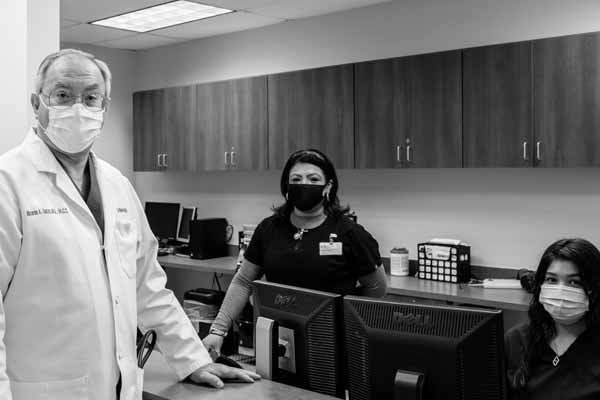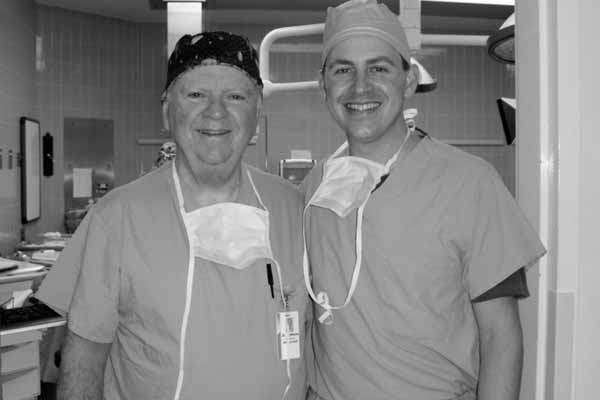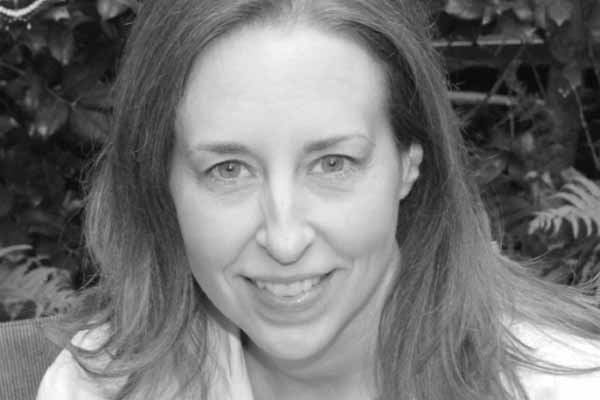
As June began, Ricardo Garza, MD, was still walking the tightrope: standing, but unable to withstand another gust of wind.
COVID-19 swept away about 35% of the San Antonio solo cardiologist’s practice revenue, and that was just what he could calculate as he waited for insurers to process straggling claims. But he had returned to in-office operations without any layoffs.
He anticipated that by August, his revenues would return to pre-pandemic levels. But that hope carried a caveat of which he and many other Texas physicians had to be mindful.
“Any sort of setback, anything that would scare the populace, the patients, from coming back will be very harmful, will be very disruptive,” Dr. Garza said. “At that point, if we were to have a second wave … and patients were not to come to the office, we would then probably have to furlough some staff members. We wouldn’t be able to handle a second wave, I don’t think.”
And yet, as this story went to press in late June, a second wave seemed plausible. On June 25 Gov. Greg Abbott reinstated an executive order restricting non-emergent, elective procedures in hospitals, albeit more limited than the first one issued in March. The move came as Texas began experiencing a tremendous spike in new COVID-19 cases and hospitalizations weeks after the state reopened its businesses.
While some practices are surviving – and trying their best to prepare for future threats – others weren’t so lucky.
On-the-ground experiences align with the Texas Medical Association’s Practice Viability Survey in showing COVID-19 was, and still is, a disruptor unlike any other – challenging or torpedoing the viability of various practice types. (See “How Has COVID-19 Affected Your Practice?” pages 26-27.)
Pushed to the edge
Thirty-seven years after he opened his first office in the East Texas town of Athens, ophthalmologist Bob Nettune, MD, simply didn’t have a way to reopen those doors. His son, also an ophthalmologist, did, but his path was rocky and the future still uncertain.
Dr. Nettune had entered 2020 planning to retire in about two years, capping a professional journey in which medicine was his second career; he was originally a corporate attorney. Dr. Nettune split his time between his original office and others in nearby Kaufman and Cedar Creek Lake.
“My office manager was turning 65 in two years, and we were going to walk out the door together,” Dr. Nettune said. “She was going to retire at 65, and then I was going to retire just short of 80.”
When the pandemic began, Dr. Nettune started by closing his offices for two weeks. That turned into three. And then more.
“I kept thinking, well, maybe if I’m real careful and I wear my N95 mask all the time in the clinic, that I would be able to get back in and see patients,” he said.
He waited for a clear message that the virus threat was dissipating – a sign that as an ophthalmologist and surgeon, an “in your face” physician, he wouldn’t be at such high risk. Like the rest of the world, he kept waiting.
“Then combine that with, if I go ahead and operate on any of these folks, I have to give them a 90-day global period that I have to provide continued service in addition to the surgery. That would obligate me to be in practice for another three months in this unknown period. That was too much,” he said. “I just couldn’t take the chance of subjecting myself to the risk.
“I think we ended up giving [it] about six weeks,” he said. “We just kept waiting and waiting, and clarity didn’t come with this disease. So I finally had to say – really tough decision – I said we’d better close it down.”
Meanwhile, Dr. Nettune’s son, a cornea and cataract specialist in Dallas and Plano, was surviving but hurting. Greg Nettune, MD, told Texas Medicine his seven-physician practice, Cornea Associates of Texas, lost the vast majority of its monthly revenue and furloughed staff before it obtained funds from the federal government’s Paycheck Protection Program (PPP). Those funds and cash reserves helped Cornea Associates push through and rehire all of its staff.
“Ophthalmologists have really high overhead, probably have some of the highest overhead of any specialty, partly because of the space and equipment we need and the microscopes and lasers and things that are just very expensive,” Dr. Greg Nettune said. “At 50% volume, we’re still not actually making money yet, so we really need to be right around 70% to be a viable business. Hopefully, we can keep it going.
“I’m worried a little bit. I don’t see how we’re ever going to go back to that pre-COVID volume, just because of social distancing. You can’t have the same amount of patients coming through the office.”

The telemedicine life raft
TMA’s Practice Viability Survey found most Texas physicians saw their salaries and work hours slashed as a result of the pandemic. (See “How Has COVID-19 Affected Your Practice?” pages 26-27.)
One of those physicians was Dallas gynecological surgeon Wesley Anne Brady, MD. Her practice revenue fell by more than 90% during the roughly six-week period when elective procedures were banned under Gov. Greg Abbott’s first executive order in March. Dr. Brady stopped paying herself during those six weeks, but by June, her solo practice had bounced back. Fortunately, Governor Abbott’s second executive order did not affect outpatient surgery centers, where she does a lot of her procedures.
“Over the last six weeks, I’ve been saving every penny. So I’ll be able to keep the office open, I hope, and keep my employees employed, and just do the best I can,” she said after the new order.
Telemedicine consultations kept the practice from hitting rock bottom. That and $64,000 from the PPP were godsends. The outpatient center where Dr. Brady performs most of her surgeries reopened in May. Patients were ready and willing to come back in for elective procedures, and she immediately enjoyed one of her busiest months. She told Texas Medicine in early June that month was already booked, as was July.
“The unknown was scary,” Dr. Brady said. “But I knew that we would get through it – just buckle down, work together. There’s nothing we could really do about it except follow the rules and be flexible, go with the flow. My staff was wonderful. They were real understanding, and when they were at home, we updated the website and did lots of projects that we didn’t have time to do when we were so busy at the office.”
Telemedicine also became a life raft for Dr. Garza, as it did for countless other doctors. (See “The Tele-Future Is Now,” July 2020 Texas Medicine, pages 15-19, www.texmed.org/TelemedFuture.)
During the first period of restrictions on medical care, he couldn’t order imaging procedures, which he says make up about 25% of a cardiologist’s revenue. But virtual visits allowed him to see essentially the same number of patients as he normally does. He made it through that restricted period without laying off any of his four medical assistants.
“Probably the greatest adjustment we made – truly critical – was the understanding that in-person visitation was going to be impossible,” he said. “And there are ongoing care issues with patients. Blood pressure adjustments, laboratory tests come back, and adjustments in their cholesterol medicines: These are the routine, day-to-day things that all … cardiologists who see patients have to manage. Not to mention symptomology: ‘I’m a little short of breath, my blood pressure’s high.’ Those things persist despite the patient’s inability to come into the office structure. Telemedicine became our only real means of continuing the care.”
However, Dr. Garza says the second wave of restrictions will affect cardiology patients who schedule elective procedures at the hospital through his office, such as diagnostic cardiac catheterizations.
“That’s a whole lot of admissions from a cardiologist’s perspective,” he said. “The other issue is we get into the circumstance where patients become obviously … apprehensive about leaving their environment. And even though … stress testing, as an example, was not precluded, we could still do stress testing to evaluate patients, but patients themselves are just apprehensive about coming. They will put off doing some of that routine evaluation testing.”
For independent practices, he said, “this is the moment to sink or swim. And the only swimming I see available, the only life raft, is going to be doing more telemedicine. I think we have to go all-in; this is the way we’re going to maintain connection to our patients so we can continue their care plans and adjust their medications and adjust their care.”
Telemedicine also provided a buffer while pediatricians like Michael Bornstein, MD, waited for U.S. government funding to materialize; the initial $50 billion allocated under the federal CARES Act went only to practitioners who took Medicare patients. Dr. Bornstein, who runs an independent all-pediatrics practice in Richmond near Houston, told Texas Medicine he’d lost about 70% of his practice revenue at the start of the pandemic; that figure “improved” to 50% by June.
Dr. Bornstein said his survival methods included shutting down one of his three offices; dividing his large waiting room into “sick” and “well” sides; advertising those precautions to his patients and reminding them to come in for well visits; and receiving two small-business loans, including PPP funds.
“My plan is to never lay anybody off and for everything to go back to normal. What my big hope is, is that No. 1, I don’t ruin everything I’ve built over the last 27 years,” he said. “I can empty out my retirement funds and empty out all my savings and just work until I’m 80. I hope that doesn’t happen. But I’m optimistic that it comes to an end, that people start coming in to [do] well checkups, because this is the well-checkup time of the year.”
Survival tactics
Like most physicians and business owners, Dallas pulmonologist Michelle Chesnut, MD, wasn’t fully prepared for the pandemic. Yet, in a sense, she’d been preparing for it all along.

Dr. Chesnut told Texas Medicine she and her practice partner of 12 years gave themselves a leg up on COVID-19 practice survival because they run a “lean” operation with almost exclusively outpatient work and very little hospital-based activity. With an extremely vulnerable population of patients with underlying pulmonary conditions, Dr. Chesnut quickly decided in mid-March to go to telehealth visits exclusively and jumped to collect a loan during the first round of PPP funding.
“I was talking to the bank at 10 at night on a Friday night when that PPP program opened, trying to get all of our stuff through as quickly as possible,” she said, “because we knew the money was going to run out very, very quickly, which it obviously did.”
Even those quick and proactive steps didn’t shield the practice’s bottom line. Dr. Chesnut says in March her practice experienced a 25%-30% drop in revenue; in April, those figures plummeted to roughly 75%. Multiple factors contributed to that drop, she says, including patients being intimidated by telemedicine and restrictive requirements on its use until commercial and government insurers temporarily loosened them.
“Our older patients didn’t even have devices that they can do telehealth on. … Some patients just said, ‘It’s OK, I’m just going to reschedule and I’ll see y’all after all this is over.’ Because I think a lot of patients at that time thought, ‘This is going to be a month, and then it’s going to blow over, and I’ll just reschedule my appointment.’ Obviously, we know now that’s not true,” she said.
“And like most practices, what we do is not just the evaluation and management code; it’s not just the office visit. We have a full pulmonary function lab in our office, and pulmonary function testing is something that is separately billed for from the office visit. When we went to telehealth, all of that billing immediately went to zero.”
Fortunately, the practice weathered the losses without laying off or furloughing any staff and returned to in-person visits in early June.
“Now that we’ve gotten through it, we know that we can do it, and we hopefully served the patients the best that we could under the circumstances. I feel lucky that the economic part of it, it’ll be OK. We’ll get through it.”
Similarly, internist John Flores, MD, says his Little Elm Medical Clinic’s abrupt transition to all-telemedicine was easier than it would’ve been otherwise because of low overhead costs. The two-physician practice near Dallas owns its building, and its mortgage payments are lower than many rent payments would be. It also outsources many of the business aspects of the practice to firms that handle human resources, marketing, and information technology. Those services charge Little Elm a percentage “pretty reasonable compared to what I used to pay for billing alone,” Dr. Flores said.
“Granted, our percent of visits went down about 30%, as did our income. But luckily, with our overhead being lowered, that didn’t get into our overhead,” he added. “We just ended up where we made less money. And we did get a PPP loan, which the business firm that we contracted with, they were on top of that.”
Practicing in uncertainty
The bounce-backs are encouraging. But as of this writing, uncertainty remained amid a spike in cases and hospitalizations in June. Physicians found reason to be optimistic and pessimistic.
“As we told my father, who’s an 87-year-old: We took a punch, we’re still standing, but I don’t know if we can take another punch,” said Dr. Garza, the San Antonio cardiologist. “Another punch might put us on the canvas.”
Though Dr. Bornstein tends to be optimistic, with payroll accounting for 40% of his expenses, he’s prepared for the possibility of laying off staff to avoid closing his office completely.
“My original patients, I’m seeing their children. Babies that I helped deliver, now I have working for me. I don’t want to lay people off. But that … has to be the first thing I would do, as I would say it’s the most money. It doesn’t make sense (to do anything else); I can’t not order cotton balls, but that’s cheap anyway. It’s really the salaries that eat up most of the money, and vaccines. And I have to have vaccines. I can’t have people coming in and go, ‘Well, I can’t give you any vaccines, because I couldn’t afford them.’”
Dr. Bob Nettune, forced to shutter just shy of four decades after he began, struggles to come up with solutions for doctors to brace for another pandemic or anything like it: “Boy, I don’t know how you prepare for something like this.”
But Dr. Chesnut sounds a note of optimism, saying while COVID-19 couldn’t have been anticipated, it forced her office to get creative.
“I don’t think we ever felt like we were going to have to throw in the towel and it was going to be impossible. I guess if it went on forever and ever and ever,” she said. “But I think we could see that there was a way that we were going to be able to get back into the office safely and bring patients back into the office.”
A broader concern will be COVID-19’s impact on physician practice in light of this year’s overall economic realities. On June 8, the National Bureau of Economic Research officially declared that the U.S. had been in a recession since February.
Dr. Flores, immediate past chair of TMA’s Council on Socioeconomics, said in June that the next six months are a concern for him.
“When the recession hit back in ’07, ’08, ’09, it really caused a lot of people to lose their job, lose their insurance, and basically not be able to afford to take care of their chronic conditions. And we already saw a huge drop in the number of … those patients coming in to take care of themselves – their diabetes, their blood pressure, their cholesterol – because some were concerned about being exposed,” he said. “At the same time, we didn’t want to expose them, because we really didn’t know what was going to happen with the COVID.
“Now, I’m more concerned about [whether] what happened 13 years ago would happen again in the next six months. Because really, long-term, that’s more worrisome.”
Tex Med. 2020;116(8):20-25
August 2020 Texas Medicine Contents
Texas Medicine Main Page